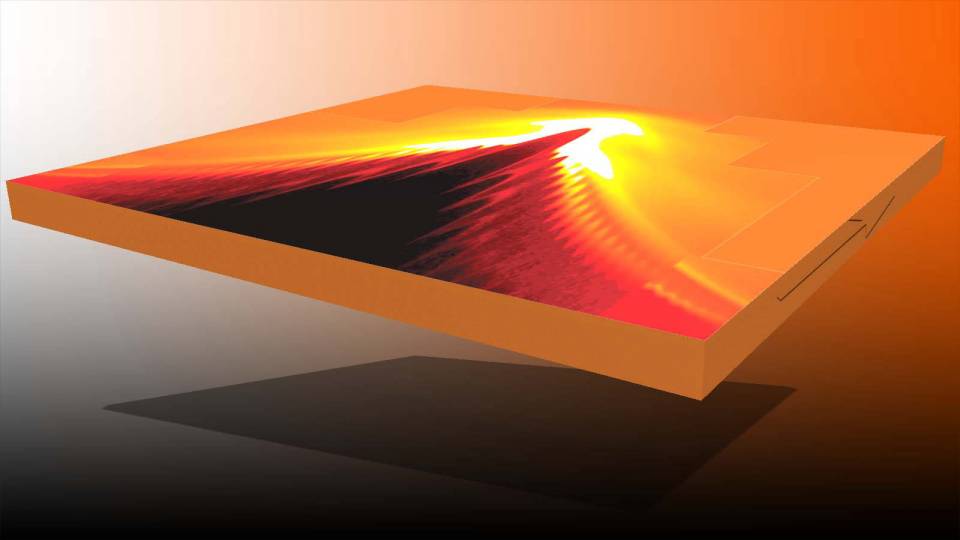A team of scientists led by researchers from Princeton University has discovered a new way that electrons behave in materials. The discovery could lead to new kinds of electronic devices.
Writing in the Friday, July 25, issue of the journal Science, a team led by N. Phuan Ong, a professor of physics at Princeton, has shown that electrons in the common element bismuth display a highly unusual pattern of behavior -- a dance, of sorts -- when subjected to a powerful magnetic field at ultra-low temperatures.
Normally, electrons in bismuth come in three different varieties. But in the experiment described by the researchers, the electrons in the magnetized, supercold sample simultaneously assumed the identity of all three classes of electrons, following a strict choreography that could only stem, they say, from the strange rules of quantum physics. Quantum mechanics is the area of physics that governs the behavior of objects in the microscopic world.
The experiment documented the first "phase transition" -- a term used to describe an abrupt change in the behavior of a material -- ever observed in a Group V element, one of the categories in chemistry's periodic table.
"If you can imagine, it's as if we were looking at passengers scrambling through Grand Central Station in New York, watching them run in different directions. All of a sudden, the whistle blows and we see them run to the same train. This is a simple example of a sudden transition to collective behavior," Ong said.
By witnessing what physicists call a "collective state," the team saw what Ong described as one of the wonders of nature. "It's a manifestation of quantum mechanics," he said.
It had been known that, in the complicated environment of a crystalline solid like bismuth, its electrons move more rapidly than they do in conventional materials. Although the maximum speed of electrons in bismuth is small compared with photons moving at the speed of light, the electrons mimic accurately the behavior of elementary particles accelerated to very high speeds. In bismuth, this "relativistic" property makes them likely candidates for the quantum behavior the scientists observed.
"This is exciting because this was predicted, but never shown before, and it may eventually lead to new paradigms in computing and electronics," said Thomas Rieker, program director for materials research centers at the National Science Foundation.
If scientists are able to document the behavior of the electrons in bismuth and therefore predict their path through a material, they may be able to manipulate those properties for electronic systems powering futuristic "quantum" computing devices.
"In the quest to develop ever smaller and faster transistors, physicists and engineers are attempting to harness the quantum behavior of electrons," Ong said. "Research in bismuth and another material, graphene, may uncover further new results that will expand the toolkit of quantum researchers."
Electrons are the lightest elementary particles with an electric charge. In the past, understanding the rules governing the way electrons move through materials has allowed scientists to make major advances, from the development of medical imaging to the invention of the transistor. "The modern era of computing and telecommunications rests on advances in solid state physics," Ong said. "We can't yet know what we will learn from this but the past tells us that understanding the behavior of electrons points us in important new directions."
The experiment also involved Robert Cava, the Russell Wellman Moore Professor of Chemistry and department chair, as well as physics graduate students Lu Li and Joseph Checkelsky and postdoctoral fellow Yew San Hor. Scientists from the University of Michigan and the University of Florida also participated.
To obtain the results, the scientists balanced a crystal of high-purity bismuth at the tip of a tiny gold cantilever and measured the minute flexing of the cantilever as the magnetic field changed. They performed the experiment using the most powerful magnet in the world at the National High Magnetic Field Laboratory in Tallahassee, Fla. The 34-ton magnet produces a magnetic field measuring 45 Teslas -- 1 million times more powerful than the Earth's magnetic field. The facility is funded by the National Science Foundation, the U.S. Department of Energy and the state of Florida.
The research at Princeton was supported by the National Science Foundation through a Materials Science and Engineering Center grant to the Princeton Center for Complex Materials.

